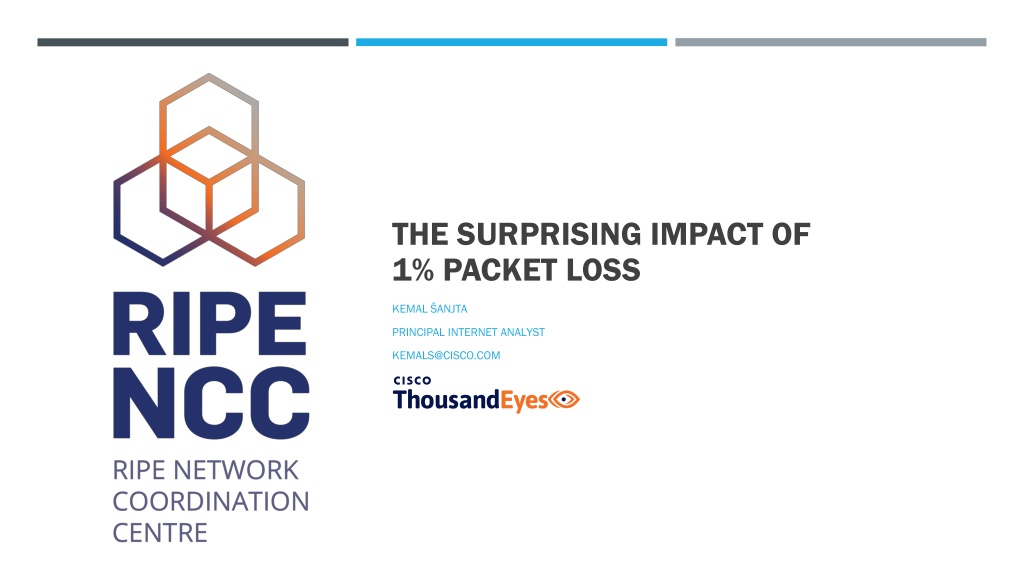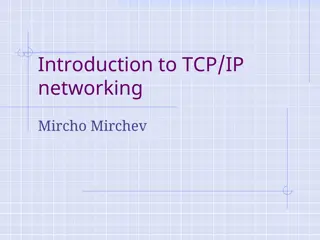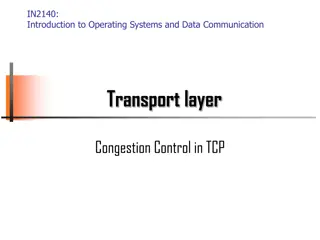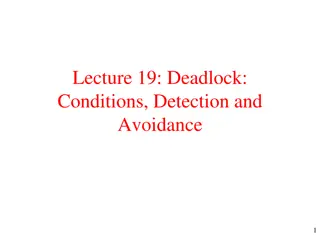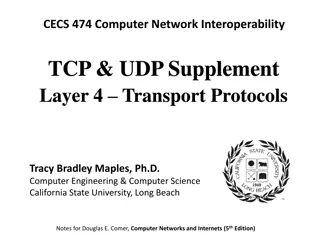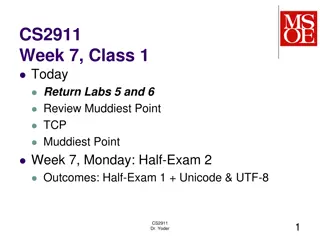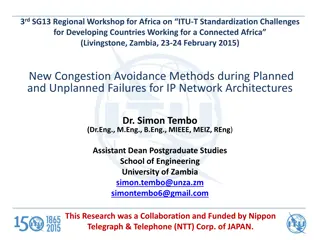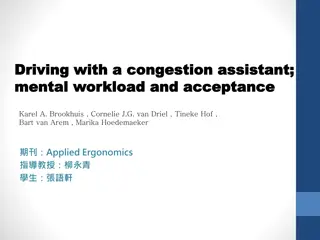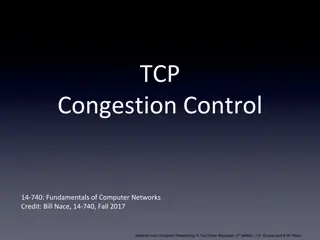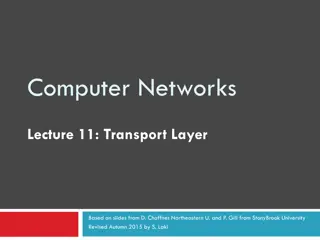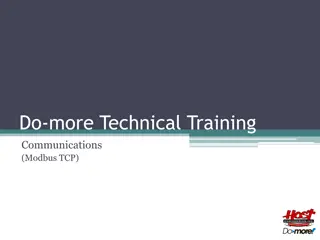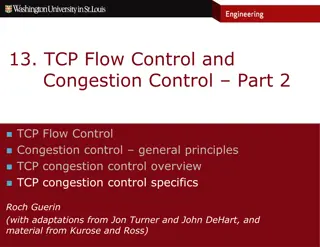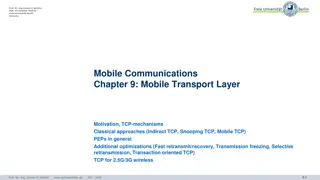Understanding the Impact of 1% Packet Loss on TCP and the Cubic Congestion Avoidance Algorithm
Delve into the surprising effects of even 1% packet loss on network flows, the methods TCP uses to mitigate loss, and how the CUBIC congestion avoidance algorithm works. Explore the researched but not quantified problem of packet loss and learn about a test methodology using Ubuntu hosts to measure throughput effectively.
Download Presentation

Please find below an Image/Link to download the presentation.
The content on the website is provided AS IS for your information and personal use only. It may not be sold, licensed, or shared on other websites without obtaining consent from the author. Download presentation by click this link. If you encounter any issues during the download, it is possible that the publisher has removed the file from their server.
E N D
Presentation Transcript
THE SURPRISING IMPACT OF 1% PACKET LOSS KEMAL ANJTA PRINCIPAL INTERNET ANALYST KEMALS@CISCO.COM
RESEARCHED BUT NOT QUANTIFIED PROBLEM Intricacies of TCP are well researched Packet loss has negative effect on flows Not something that we quantify often Network engineers tend to look past small levels of packet loss (say 1 or 2%)
VARIOUS METHODS TCP USES TO HANDLE PACKET LOSS Duplicate ACKs Timeouts Explicit Congestion Notifications (ECN) Selective Acknowledgements (SACK) Congestion Avoidance Algorithms
CUBIC: THE DEFAULT CONGESTION AVOIDANCE ALGORITHM Given increased popularity of the Internet and growth of networks, network engineers realized that earlier congestion avoidance algorithms such as Tahoe, utilized available bandwidth slower than they should, especially in higher-bandwidth networks Default congestion avoidance algorithm on all major operating systems
CUBIC: HOW IT WORKS? Congestion Window Adjustment Congestion Window Adjustment CUBIC employs a cubic function to adjust the congestion window size The congestion window is increased aggressively during the slow start phase and cautiously during congestion avoidance. It reduces the congestion window sharply upon detecting packet loss, indicating network congestion Window Scaling Window Scaling Adjusts the congestion window size based on the current network capacity and congestion level TCP Timestamps TCP Timestamps CUBIC uses TCP timestamps for fine-grained measurement of round-trip time (RTT). Helps in estimating the available bandwidth and adjusting the congestion window accordingly Congestion Avoidance Congestion Avoidance Once the congestion window reaches a certain threshold, CUBIC switches to congestion avoidance mode. It increases the congestion window size gradually, probing for additional bandwidth without inducing congestion Packet Loss Reaction Packet Loss Reaction CUBIC reacts to packet loss by reducing the congestion window size sharply Implements an additive increase, multiplicative decrease (AIMD) approach to adjust the congestion window dynamically
TEST METHODOLOGY Five Linux (Ubuntu 22.04) hosts configured to forward packets 1Gbps connectivity between devices Static routing Sub interfaces configured on hosts, required VLAN configuration on switch Measuring throughput using iperf3 Unlike bandwidth, which represents the maximum capacity of the channel, throughput reflects the real-world performance and efficiency of the data transmission process
SYMMETRIC AND ASYMMETRIC NETWORK PATHS Symmetric network (forward and reverse traffic path is the same) Asymmetric network (reverse traffic is taking a different path when compared to the forwarding path)
ESTABLISHING A BASELINE (NO PACKET LOSS) Baseline (asymmetric) Baseline (symmetric) Mean 804.673506 Mean 864.139471 STD 13.0217464 STD 14.647341 Min. 710 Min. 720.067 25% 799.99 25% 859.973 50% 809.93 50% 869.965 75% 810.046 75% 870.3815 Max. 830.419 Max. 900.002 804.6 Mbps and 865.13 Mbps of Throughput for symmetric and asymmetric network, respectfully Asymmetric network traffic saw 7.3% increase in Throughput over symmetric network
INTRODUCING PACKET LOSS tc ("traffic control") utility tc has capabilities such as shaping, scheduling, policing, and dropping Enhancement called netem ("network emulation") that allows adding delay, packet loss, duplication, and other characteristics to packets outgoing from a specific network interface
THE CURIOUS CASE OF 1% PACKET LOSS On average, 1% of packet loss causes 70.0%+ decrease in throughput! On average, 1% of packet loss causes 70.0%+ decrease in throughput! 804.6 Mbps of Throughput at baseline, 235.5 Mbps of Throughput at 1% loss in symmetric topology 864.13 Mbps of Throughput at baseline, 222.4 Mbps of Throughput at 1% loss in asymmetric topology
THE CURIOUS CASE OF 1% PACKET LOSS 1% (symmetric) 1% (asymmetric) Mean 235.513105 Mean 222.493196 STD 13.5692798 STD 13.7883065 Min. 93.967 Min. 51.21 25% 229.667 25% 214.788 50% 236.635 50% 222.729 75% 243.596 75% 230.675 Max. 281.886 Max. 280.877 1% of packet loss caused a 70.7% decrease in throughput in symmetric network 1% of packet loss caused a 70.7% decrease in throughput in symmetric network topology, while in asymmetric topology it resulted in 74.2% decrease in throughput! topology, while in asymmetric topology it resulted in 74.2% decrease in throughput!
OVERALL RESULTS Symmetric network 1% 2% 3% 4% 5% 6% 7% 8% 9% 10% Mean STD Min. 235.51 13.57 93.97 229.67 236.64 243.6 281.89 175.19 37.48 11.93 158.09 190.91 199.86 223.72 109.76 46.68 65.68 36.09 41.37 25.48 23.95 17.31 16.75 12.16 11 8.4 7.52 5.97 5.29 4.33 0 0 0 0 0 0 0 0 0.25 0.5 0.75 74.56 111.86 150.14 201.33 37.77 61.67 89.53 175.49 21.38 37.77 57.18 149.62 9.94 19.89 33.81 119.3 6.96 13.92 23.37 87.5 4.97 8.95 15.41 68.59 2.98 5.97 9.95 46.76 1.99 3.98 6.96 37.78 Max. Asymmetric network 1% 2% 3% 4% 5% 6% 7% 8% 9% 10% Mean STD Min. 222.49 13.79 51.21 214.79 222.73 230.68 280.88 168.03 34.91 5.97 151.14 182.45 191.89 212.79 106.43 44.62 63.57 34.81 36.59 24.44 24.99 16.93 15.52 11.58 10.82 8.26 36.59 24.44 15.52 11.58 0 0 0 0 0 0 0 0 25% 50% 75% 72.57 108.35 144.67 188.91 35.8 59.66 16.9 31.84 51.7 148.64 11.93 21.87 34.79 118.81 5.97 11.94 21.87 82.03 4.97 8.95 14.92 63.64 16.9 31.84 51.7 148.64 5.97 11.94 21.87 82.03 87 Max. 163.07
OVERALL RESULTS VISUALISED Throughput achieved in symmetric network Throughput achieved in asymmetric network
BBR: THE FUTURE OF CONGESTION AVOIDANCE? BBR stands for Bottleneck Bandwidth and Round-Trip Time It is a congestion control algorithm developed by Google Designed to optimize network utilization and throughput by continuously probing for the available bandwidth and adjusting sending rate accordingly
BBR: HOW IT WORKS? Bandwidth estimation Bandwidth estimation BBR estimates the available bandwidth by measuring the delivery rate of packets Uses concept of pacing to ensure a steady flow of packets without causing undue congestion Round Round- -Trip Time (RTT) Estimation Trip Time (RTT) Estimation Maintains an estimate of the minimum RTT of the connection RTT variations are used to adjust the pacing rate, ensuring smooth transmission and reduced latency Bottleneck Detection Bottleneck Detection Identifies the bottleneck link in the network path through various techniques like probing for increased delivery rates and utilizing RTT feedback Congestion Window Management Congestion Window Management Adjusts the sending rate by maintaining two parameters: pacing gain and probing gain Low Latency Operation Low Latency Operation Aims to keep the queue size low, which helps in reducing latency
KEY DIFFERENCES BETWEEN CUBIC AND BBR Congestion Window Adjustment Congestion Window Adjustment CUBIC CUBIC: Adjusts congestion window based on cubic function, reacting strongly to loss BBR BBR: Dynamically adjusts sending rate based on bandwidth and RTT estimations, avoiding unnecessary loss Bandwidth Estimation Bandwidth Estimation CUBIC CUBIC: Relies on packet loss as an indicator of congestion BBR BBR: Actively probes for available bandwidth and adjusts sending rate, minimizing latency Latency Optimization Latency Optimization CUBIC CUBIC: Prioritizes throughput over latency, potentially leading to increased latency under heavy congestion BBR BBR: Maintains low latency by continuously monitoring network conditions and adjusting congestion control parameters accordingly Implementation Implementation CUBIC CUBIC: Widely adopted in many operating systems and network devices BBR BBR: Developed by Google for its data centers, gaining adoption in various platforms and protocols.
ENABLING BBR cat /proc/sys/net/ipv4/tcp_congestion_control Verify currently configured algorithm cubic echo "net.core.default_qdisc=fq" >> /etc/sysctl.conf Enable BBR echo "net.ipv4.tcp_congestion_control=bbr" >> /etc/sysctl.conf sysctl -p cat /proc/sys/net/ipv4/tcp_congestion_control Verify that BBR is configured bbr
ESTABLISHING A BASELINE WITH BBR (NO PACKET LOSS) Baseline (symmetric) Baseline (asymmetric) Mean 868.50 Mean 827.20 STD 49.36 STD 46.06 Min. 679.99 Min. 639.99 25% 860.15 25% 839.92 50% 889.99 50% 840 75% 890 75% 849.99 Max. 900.31 Max. 860.26 868.5 Mbps and 827.20 Mbps of Throughput for symmetric and asymmetric network, respectfully Asymmetric network traffic saw 4.7% decrease in Throughput over symmetric network
MEASURING IMPACT OF 1% PACKET LOSS WHILE USING BBR On average, 1% of packet loss caused 8.5% decrease in throughput while using On average, 1% of packet loss caused 8.5% decrease in throughput while using BBR, stark difference to 70.7% decrease using CUBIC! BBR, stark difference to 70.7% decrease using CUBIC!
MEASURING IMPACT OF 1% PACKET LOSS WHILE USING BBR 1% (asymmetric) 1% (symmetric) Mean 763.42 Mean 794.06 STD 44.28 STD 44.08 Min. 519.96 Min. 489.99 25% 760 25% 800.33 50% 779.99 50% 809.99 75% 789.98 75% 810.01 Max. 830.08 Max. 810.41 1% packet loss, in symmetric network topology using BBR, caused 8.5% throughput decrease compared to 70.7% throughput decrease in the same topology while using CUBIC In asymmetric network topology using BBR, we saw 7.7% throughput decrease compared to 74.2% decrease in throughput while using CUBIC
OVERALL RESULTS WITH BBR Symmetric network 1% 2% 3% 4% 5% 6% 7% 8% 9% 10% Mean STD Min 794.06 44.08 490 800.34 810 810.01 830.09 791.65 44.58 370 799.99 809.93 810 830.76 768.94 47.55 140 779.99 780.02 790 810.53 775.34 50.11 280.05 780.27 790 790.2 831.33 773.7 56.29 209.86 788.9 790 790.25 820.09 787.71 61.42 784.07 64.99 130 799.99 800 810 830.07 644.04 268.31 761.61 76.86 751.89 77.96 0 0 0 0 25% 50% 75% 800 750.01 769.99 770.02 800.09 780 770 770.8 780 800.2 800.92 810 831.26 780.03 790 810.07 Max Asymmetric network 1% 2% 3% 4% 5% 6% 7% 8% 9% 10% Mean STD Min 763.42 44.28 519.96 760.01 780 789.99 810.42 822.11 46.83 500 830 839.99 840.01 860.04 795.6 48.91 270 800.02 810 819.98 840.08 812.53 53.64 249.83 820.01 830 830.07 850.17 792.47 57.29 160 800.33 810 811.09 840 793.79 62.64 39.98 809.6 810 819.98 840 750.63 63.99 749.33 68.44 760.8 73.83 751.64 81.68 0 0 0 0 25% 50% 75% 760.01 770 770.05 820 760 770 779.98 780.01 790 810.14 770 779.77 780.01 800.07 770.03 810.09 Max
BBR PRODUCTION TESTING Single POP (Tokyo) testing at Dropbox Performance comparison between BBRv1 and BBRv2 Performance comparison with CUBIC and Reno Results indicate production readiness Subset of Spotify users Results indicate production readiness Google They built it for their use case, kind of expected Reports of Netflix working with BBR on FreeBSD Cisco Catalyst SD-WAN enables it between SD-WAN endpoints when tcp-optimization feature is selected
CONCLUSION Even the smallest amount of packet loss has extremely negative consequences on throughput Outlines importance of monitoring and addressing even minor levels of packet loss CUBIC is, still, default congestion avoidance algorithm Packet loss outcomes significantly differ based on congestion avoidance algorithm used BBR shows significantly better results at any packet loss %
